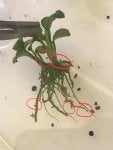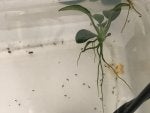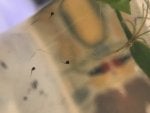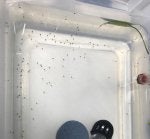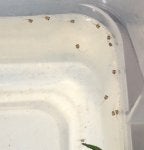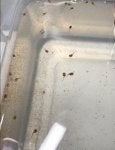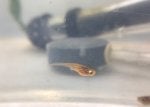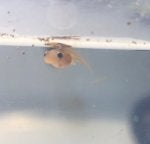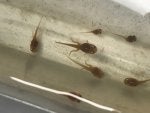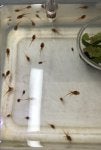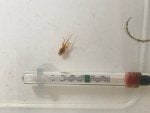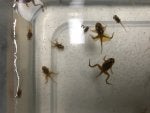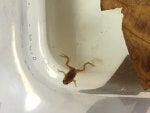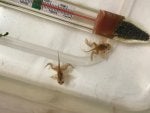DAY 33:
So far, 5 have died of complications from the infection. 4 of them were pretty severely swollen, with internal bleeding. 1 of them was a newly morphed frog that seemed relatively healthy and unaffected compared to the others. Didn't think anything was wrong with that one, but I guess not.
I've separated the ones who seem like they might have a chance as to avoid spreading bacteria from the ones who are severely infected, though I'm not sure if it will help at all. It's quite sad to see, because many of them are not dying immediately from the swelling. Some of them have been lying on their backs for days, unable to swim around or eat due to the swelling but are still alive and are still morphing. Their tails are shortening, which means their lungs are growing and soon, if they don't die from either the infection or starvation, they will die from drowning. I wish there was a more humane way to give them peace.
I have about 5 frogs who have successfully morphed, though I don't know if they will make it in the end. They seem to have trouble breaking through the surface of the water to get air so I made the water level quite low to help them out. And funnily enough, even though they had excellent eyesight and aim as tadpoles, they've really become more like adults with their horrible aim. I try to tweezer feed all of them to make sure they can eat something, but it takes a lot patience because even though the food is right in front of their face, they miss over and over, like they're doing it on purpose.

Though a couple of the ones who are officially frogs now definitely seem a bit sick, as they are unable to swim to the bottom of the water because they are buoyant. I'll have to keep watching. Right now I'm feeding everyone live blackworms that I've chopped up into small pieces, but it's hard to get them to see it as food because the worm pieces look quite similar to their poop.
The first picture is one of the newly morphed frogs, and the second picture is one that shows two of the infected froglets. The infected ones that are pictured here actually are not as bad as the ones that have already died. Some of them were very gruesome and painful to look at, because they were so engorged with fluid and had a lot of internal bleeding. Many of them are lying on their backs right now, probably on their way out. I wish there was something more that I could do, but it seems like all I can really do is watch.
I'm not sure how many, or if any at all will survive, but I will continue to update on the progress. Thanks for all your interests and advice



